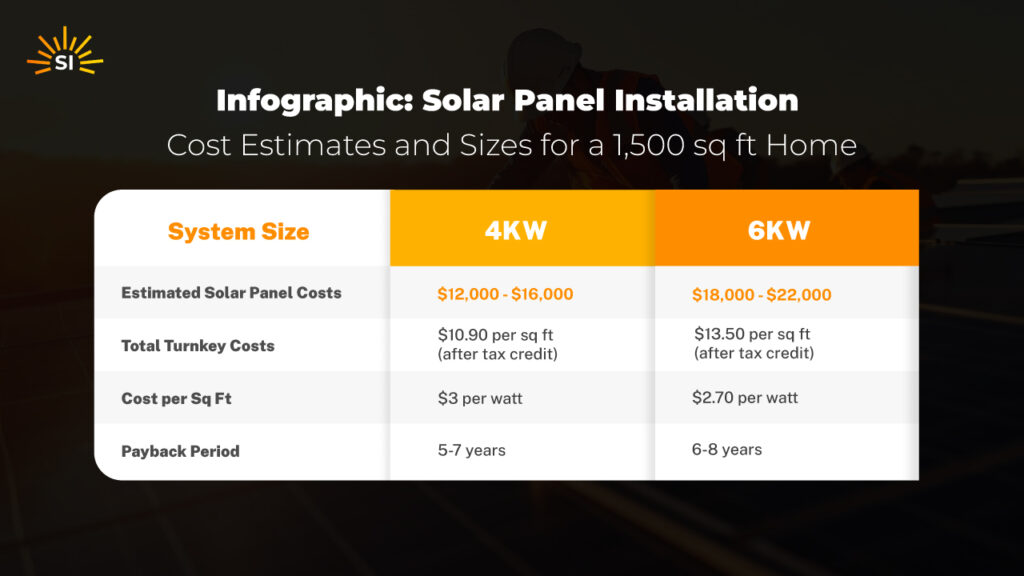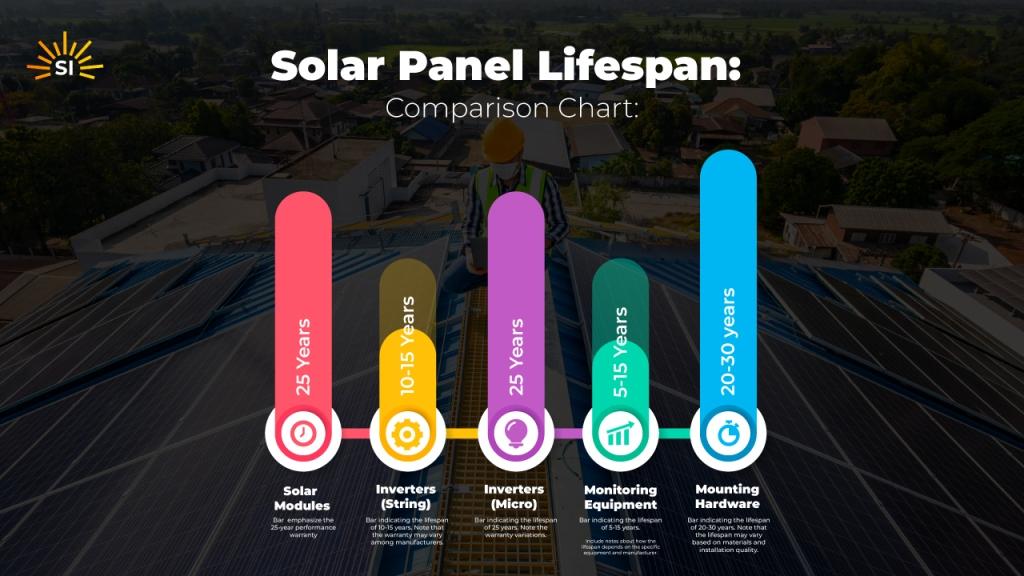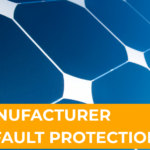
With rising electricity prices and increasing awareness of renewable energy options, more homeowners are exploring solar panel installation to slash power bills and embrace sustainability.
Solar panels offer an achievable path to energy independence and financial savings for a typical single-family house of around 1,500 square feet.
While upfront investment is required, understanding your potential system sizes, pricing breakdowns, and paths to offset costs makes embracing solar energy highly compelling.
Table of Contents
System Size and Estimated Solar Panel Costs
National averages for solar pricing at $14.75 per square foot before accounting for the federal tax credit. After claiming the 30% credit, net costs drop to $10.90 per square foot. Pay back your purchase within 5-7 years and secure household energy independence for decades.
Given a 1,500 sq ft home, a starter solar array size is a 4kW (4000 watt) system producing 16 kWh daily, nearly covering half of average home electricity usage.
Total turnkey costs for purchasing and installing a 4kW system range from $12,000 for affordable components to $16,000 for premium components. The cost is about $3-$5 a watt. This easily scales up for homes with expanded energy needs or EV charging capabilities.

Stepping up to a 6kW (6000 watt) solar system costing between $18,000-22,000 creates excess daily capacity of up to 24 kWh daily, providing scope for more significant long-term savings.
This oversupply opens opportunities to cut more of your overall utility spending through net metering programs that bank your solar credits. With conscious power usage planning, homes can offset 70-80% of total electricity bills at this expanded capacity.
Breakdown of Cost for a Solar System for a 1500 Sq Ft Home
When tallying your overall solar project price, understand the distribution across three primary cost centers:
Hardware – The physical panels, racks, mounting supplies, conduits, disconnects, signage, meters, inverters, optimizers, and monitoring devices comprise 50-65% of the total project budget. Higher-end equipment and specialty items can shift this even higher. Carefully evaluate component quality differences when reviewing quotes and warranties that influence long-term reliability.
Non-Hardware Soft Costs – The paperwork, insurance, permitting, interconnection applications, and contracting needed to get approval for installing solar involve external administrative expenses, which account for around 20% of costs. These soft costs are streamlined as local authorities gain experience permitting solar projects.
Installation Labor – The licensed electricians, construction crew, roofers, and other manpower required for safe, durable solar array deployment are key beneficiaries of your investment. Labor commands 20-25% of your quoted pricing to handle travel, logistics, and hourly rates for quality solar builders. Leveraging qualified local teams assures that they contain travel charges.
How Many Solar Panels Do You Need for a 1500 Square Foot Home?
A 1,500 sq ft house typically requires around 15 to 20 solar panels. Specifically, about 16 panels are generally needed to completely cover electrical power needs, corresponding to a 4kw to 6kw system.
However, will the number of panels needed vary based on household factors? This estimate depends on the efficiency of your solar panels, the amount of sun exposure your home receives, and your electricity usage.
Expected System Lifespans
While solar power system costs may spark initial sticker shock from homeowners, you are investing in equipment and infrastructure with exceptional functional longevity and sustained power delivery:
Solar Modules – Thanks to rigorous advancements in materials science and manufacturing quality, today’s solar panels experience minimal degradation year-over-year. Tier 1 solar manufacturers confidently back their premium products with 25-year performance warranties, ensuring 80% productivity or greater for decades after installation.
Inverters, Monitoring – The brains converting solar energy to usable electricity have shorter lifecycles than module materials, averaging replacements needed every 10-15 years for string inverters and 25 years for micro inverters. Swapping these out costs in the single digit thousands – not trivial but nowhere near the initial system cost scale. Remote performance monitoring software also evolves frequently but is easily upgradeable.

Key Cost Reductions
Solar power incentives make obtaining these grid independence and sustainability upgrades very affordable, thanks to policymakers’ commitments to progressing renewable energy adoption.
Federal Solar Investment Tax Credit – The 30% personal/corporate tax credit on total solar system costs. This deduction reduces project pricing by nearly 30% in year one.
State Rebates and Utility Incentives – Additional state-level solar incentives, through designated renewable energy funds, slash costs another $500 to $1,000 per installed kW across hundreds of utility districts. Feed-in tariffs add further savings potential.
Financing Plans – Solar loans, solar leases, and power purchase agreements allow homeowners to adopt solar power while paying low monthly rates or zero upfront costs, avoiding hefty outlays. Energy bill savings usually exceed any financing payments.
The Long-Term Value of Solar Panels
While solar incentives whittle pricing considerably, the enduring value lies in reliable decades of free renewable energy and emerging opportunities like EV charging, battery storage for backup power continuity, and grid services.
Homeowners recognizing solar energy’s collateral benefits besides bill savings consider the premium on enhanced energy security, emerging battery storage integration for resilience during blackouts, and self-reliance displacing fossil fuels for sustainability gains as worthwhile for household upgrades.
Additionally, independent power generation shields households from market energy pricing volatility as inflation, supply chain disruption, and geopolitics increasingly pressure grid utilities to raise rates. Rooftop solar adoption futures provide households with energy cost certainty.
Protecting Your Investment
A solar monitoring and warranty plan is an excellent incentive for resale ability and value: If you plan to sell your home, a solar warranty can instill confidence in buyers.
You can highlight that your solar-powered home has a solar warranty, so repairs have been completed on time and satisfactorily, and it gives new homeowners peace of mind that they’ll be covered if something goes wrong. With Solar Insure, all monitoring and warranties are easily transferable at no additional cost and at unlimited times.
Shopping for Solar: Getting the Best Deal
With the robust demand for installing solar power, homeowners have the choice of hundreds of regional solar companies vying for their business. While televised ads and door-to-door sales pitches trigger interest, careful due diligence in selecting reputable area solar firms ensures satisfactory outcomes.
Structuring your selection criteria beyond just pricing per watt benchmarks proves prudent. Survey community solar references and review firms for certifications confirming licensed electricians’ and North American Board of Certified Energy Practitioners’ credentials.
Verify solar installer standing with BBB Business Profiles for complaints regarding service histories and confirmation of strong financiers and credit support.
Top solar contractors guide customers through permitting hurdles with local authorities streamlining your connection to the grid. They also propose optimal panel solutions for your distinct home structural and shading situation.
Getting multiple bids avoids agreeing to the first quote received. Remember – while essential for filtering offers down to end pricing – fixating purely on bottom dollar discounts often backfires on equipment quality and post-installation headaches.
Conclusion
Tackling steep energy costs, climate anxiety, and fears about power grid reliability represent shared modern burdens as communities pursue energy transitions. For 1,500 square-foot households plotting smarter, sustainable living, solar power delivers on these aspirations through affordable financing, reliable savings, and clean, renewable attributes, with install price tags dropping every successive year.
Pay back your purchase within 5-7 years and secure household energy independence for decades by taking advantage of federal tax credits before they expire. Claim your rooftop real estate for energy freedom.


